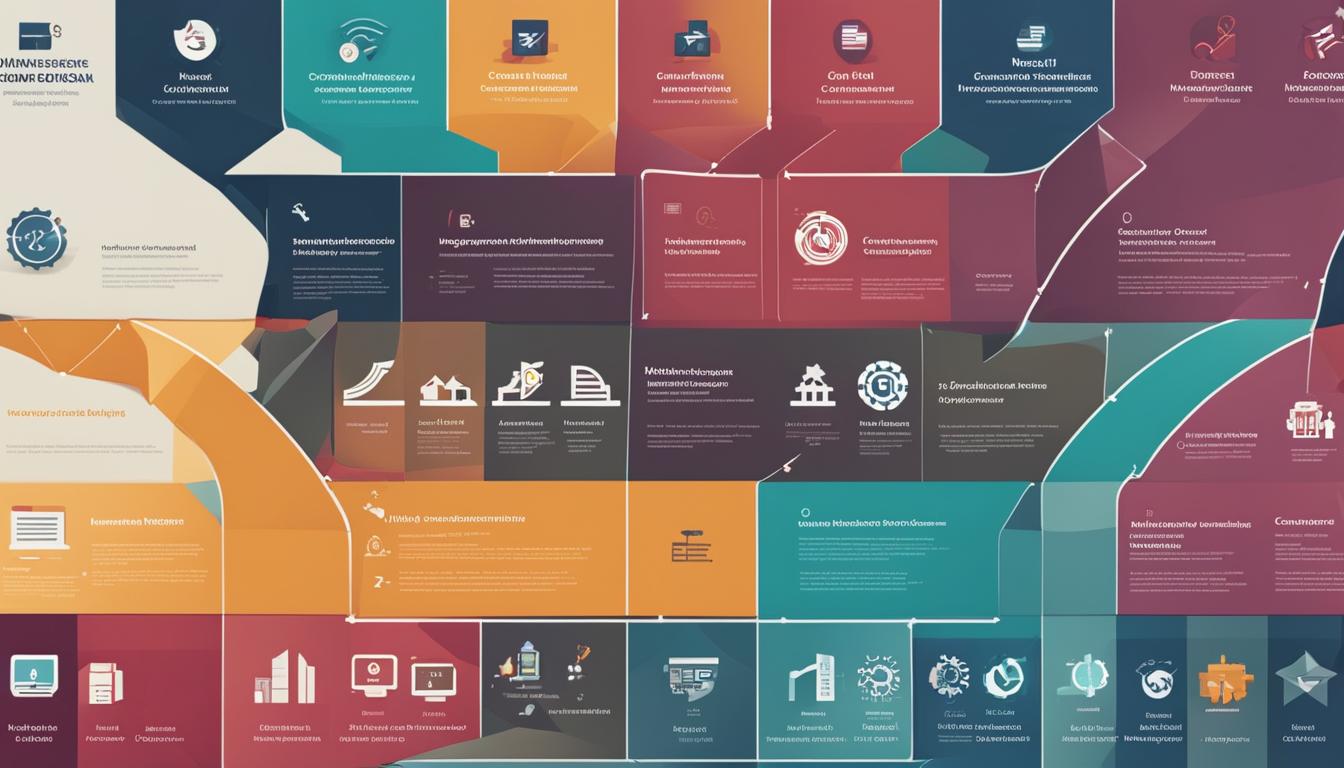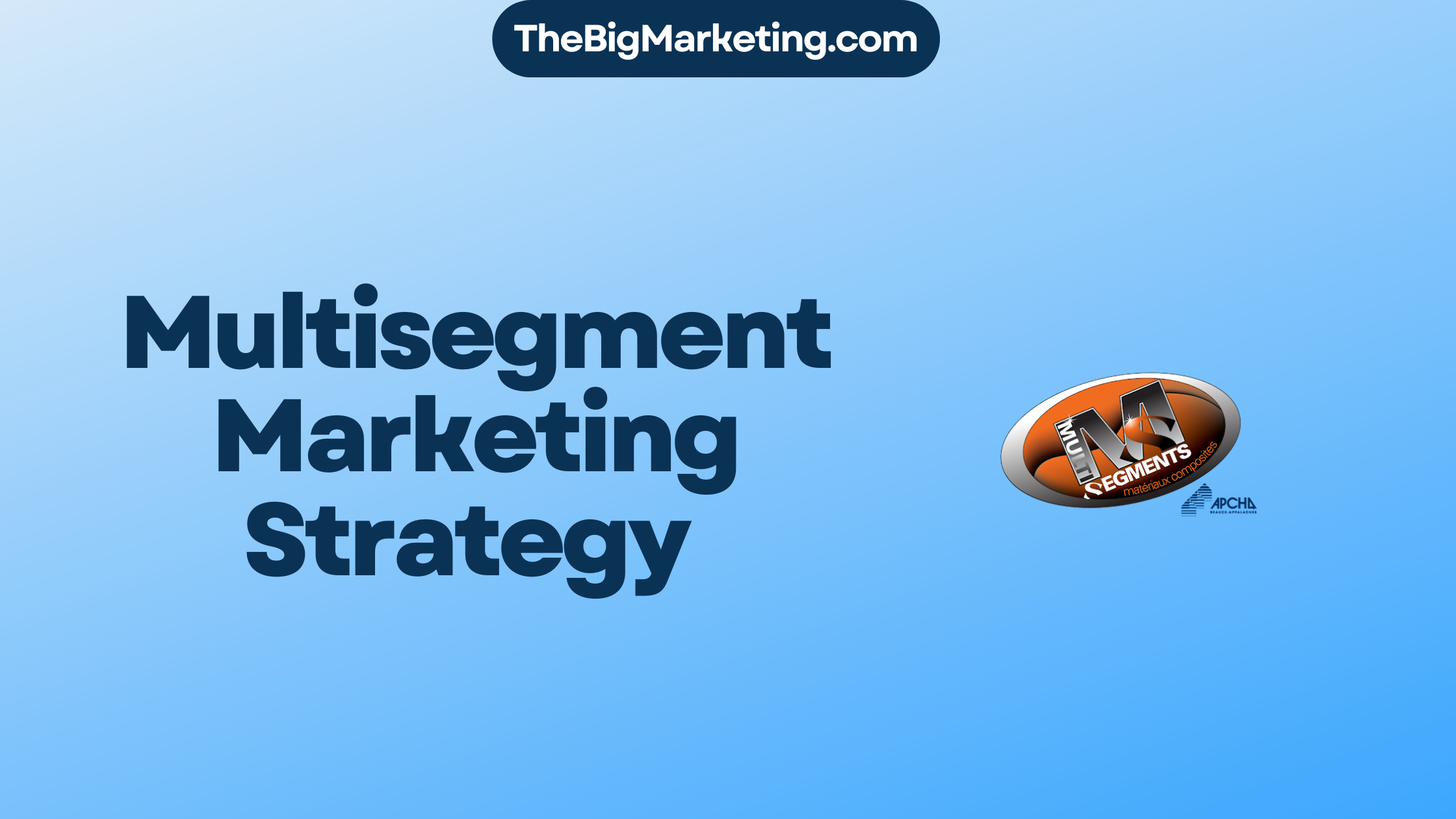In the rapidly evolving marketing industry, professionals face numerous challenges that require strategic thinking and innovative solutions. From digital marketing issues to branding obstacles, marketers need to navigate through these hurdles to drive success. In this article, we will explore the seven significant problems that marketers encountered in 2023 and provide insights on how to overcome them.
Key Takeaways:
- Facilitating strong sales and marketing alignment is crucial for business success.
- Hiring top talent necessitates offering job flexibility and opportunities for continuous learning.
- To connect with your audience, identify the social issues that matter to them and align your brand accordingly.
- Creating content that generates leads requires personalization, data-driven insights, and an understanding of the customer journey.
- Gaining and keeping followers on social media requires engaging content, user-generated content, and influencer partnerships.
Facilitating Strong Sales and Marketing Alignment
One of the key challenges faced by marketers in 2023 was the need to foster strong sales and marketing alignment within organizations. Effective communication, shared goals, and data-driven insights were crucial for driving business success.
Many organizations struggled with establishing effective communication channels between their sales and marketing teams. This lack of communication often resulted in a misalignment of goals and priorities, making it difficult to share data consistently and derive actionable insights.
However, businesses that successfully achieved alignment between their sales and marketing teams experienced significant benefits. They saw faster profit growth, improved customer retention, and enhanced overall business performance.
To overcome the challenge of sales and marketing misalignment, clear goals and objectives should be defined, accounting for both revenue generation and brand awareness. Transparent and regular communication, facilitated through meetings and collaboration tools, can help foster a shared understanding and strategy. Additionally, implementing a robust customer relationship management (CRM) system allows for the seamless sharing of data and analytics that support both teams in making informed decisions.
Effective sales and marketing alignment requires a collaborative approach and a shared commitment to business success. By aligning their efforts and working towards shared goals, organizations can maximize their sales potential, optimize their marketing strategies, and ultimately drive growth.
Hiring Top Talent
Hiring top talent was another significant challenge for marketers in 2023. The demand for skilled workers increased, leading to higher wages and benefits, as well as increased competition among employers. Additionally, employees started prioritizing work-life balance and company culture, including the option for remote or hybrid work.
To attract and retain top talent, companies needed to offer job flexibility, authentic leadership, and opportunities for continuous learning. Hiring managers partnering with talent acquisition teams, personalized outreach, clearly defined job profiles, and nurturing relationships with candidates were also strategies for overcoming this challenge.
Creating Job Flexibility
Job flexibility has become a crucial factor in attracting and retaining top talent. Employees are seeking opportunities for remote work, flexible hours, and work-life balance. By offering flexible work arrangements, companies can provide employees with the freedom to balance their personal and professional lives effectively. This can lead to increased job satisfaction, productivity, and ultimately, better business outcomes.
Emphasizing Continuous Learning
In a fast-paced industry like marketing, continuous learning is essential to staying ahead of the competition. Marketers need to constantly update their skills and knowledge to adapt to rapidly evolving technology and consumer trends. Companies that prioritize continuous learning by providing training programs, development opportunities, and access to industry resources can attract top talent who value growth and professional development.
Building an Authentic Culture
Company culture plays a vital role in attracting and retaining top talent. Employees today are looking for organizations that align with their values and provide an inclusive and supportive work environment. To build an authentic culture, companies should foster open communication, encourage collaboration, and prioritize diversity and inclusion. By creating a positive and engaging workplace culture, companies can attract and retain top talent that will contribute to their success.
Knowing the Social Issues Your Audience Cares About
Consumers today expect brands to be socially responsible and take a stance on social issues that matter to them. However, many marketers struggled to identify the social causes that their target audience cared about. To address this challenge, market research is essential. By conducting thorough market research, including surveys and social listening, marketers can gain valuable insights into their customers’ values and preferences. This enables them to understand the social issues that resonate with their audience.
Market research provides an opportunity to connect with the community and actively engage with customers. By seeking feedback and uncovering the social issues that matter most to their audience, marketers can develop strategies that create meaningful connections. Brands that authentically align themselves with social causes demonstrate their commitment to customer values, leading to increased trust and loyalty.
Moreover, sustainability has become increasingly important to consumers. By incorporating sustainability practices and offering eco-friendly products and services, brands can cater to the growing demand for environmentally conscious options.
Authenticity is key in addressing social issues. It is essential for brands to align themselves with causes that genuinely reflect their values and mission. By doing so, they avoid the perception of empty virtue signaling and gain credibility among their audience.
Understanding and addressing social issues that matter to the audience enhances a brand’s reputation and drives customer engagement. By taking the time to listen, connect, and respond, marketers can create a strong bond between their brand and their customers.
| Benefits of Understanding Social Issues | Actions to Address Social Issues |
|---|---|
|
|
Facilitating Sales and Marketing Alignment
One of the biggest challenges for marketers in 2023 was facilitating strong sales and marketing alignment. Many organizations struggled with effective communication between these two teams, leading to a lack of shared goals and priorities. This made it difficult to share data consistently and retrieve insights that could help both sales and marketing teams determine what strategies were working.
However, organizations with tightly aligned sales and marketing teams experienced faster profit growth and higher customer retention. To overcome this challenge, clear goals and objectives that differentiate between awareness and revenue should be defined. Transparent communication, regular meetings, collaboration tools, and a robust customer relationship management system can also help foster alignment between sales and marketing teams.
In addition, leveraging data and analytics can provide valuable insights into target audiences, allowing both sales and marketing teams to make informed decisions. By analyzing customer behavior, preferences, and engagement metrics, organizations can align their efforts to meet customer needs and achieve business success.
Benefits of Sales and Marketing Alignment
When sales and marketing teams are aligned, businesses can reap numerous benefits. Here are a few:
- Higher Revenue: Aligned efforts result in improved lead conversion rates and ultimately drive higher revenue.
- Better Customer Experience: A cohesive sales and marketing approach ensures a seamless customer journey, improving overall customer satisfaction.
- Improved Efficiency: Aligned teams can eliminate duplicated efforts, streamline processes, and optimize resource allocation.
- Effective Campaign Execution: When sales and marketing teams collaborate closely, they can execute targeted campaigns that effectively engage the target audience and drive results.
By fostering sales and marketing alignment and promoting effective communication, organizations can create a synergy that leads to business growth and success.
Hiring Top Talent
Hiring top talent in the marketing industry was a significant challenge in 2023. The demand for skilled workers increased, resulting in higher wages, benefits, and intensified competition among employers. Alongside this, employees started prioritizing work-life balance and company culture, seeking remote or hybrid work options. To attract and retain the best talent, companies needed to provide job flexibility, authentic leadership, and opportunities for continuous learning.
One effective strategy for overcoming this challenge is for hiring managers to partner with talent acquisition teams. By working closely together, they can identify the skillset and qualities needed for specific marketing roles, ensuring alignment with company goals and values. Additionally, personalized outreach to potential candidates can help create a positive and tailored recruitment experience.
Clearly defined job profiles are crucial in attracting top talent. Prospective employees want to understand the responsibilities and requirements of the position, as well as how it aligns with their career aspirations. By providing detailed and transparent information, companies can attract candidates who possess the desired skillset.
Another essential aspect of hiring top talent is fostering relationships with candidates. Nurturing connections through genuine interactions and effective communication can differentiate companies from their competitors. Additionally, offering opportunities for continuous learning, such as training programs or professional development initiatives, can attract ambitious individuals seeking growth.
| Hiring Top Talent Strategies | |
|---|---|
| 1 | Partnering with talent acquisition teams |
| 2 | Personalized outreach to candidates |
| 3 | Clearly defined job profiles |
| 4 | Nurturing relationships with candidates |
| 5 | Offering opportunities for continuous learning |
By implementing these strategies, companies can overcome the challenge of hiring top talent in the marketing industry. Creating an attractive work environment that promotes work-life balance, remote work options, job flexibility, and continuous learning opportunities can help companies become employers of choice in a competitive market.
Creating Content that Generates Leads
In 2023, marketers faced the challenge of creating content that effectively generated leads. With fierce competition and evolving consumer behaviors, it was crucial to develop personalized and relevant content that resonated with the target audience. This required a deep understanding of the customer journey and data-driven insights to inform content strategy.
To address this challenge, thorough market research was essential. By leveraging analytics and segmenting the target audience, marketers could gain valuable insights into their preferences, needs, and pain points. Armed with this information, they could craft content that spoke directly to the audience’s interests and motivations.
Content personalization played a key role in lead generation. By tailoring content to individual consumers based on their demographic information, purchase history, or browsing behavior, marketers could deliver more targeted and impactful messages. Personalization could involve using the recipient’s name, recommending products based on their previous purchases, or creating dynamic email campaigns that adapt to the recipient’s preferences.
Another effective strategy for generating leads through content was storytelling. By weaving narratives that captivated the audience, brands could create stronger emotional connections and enhance engagement. Storytelling allowed marketers to communicate their value proposition in a compelling and memorable way, ultimately driving leads and conversions.
Interactive experiences also proved to be powerful lead generation tools. Brands that incorporated interactive content, such as quizzes, calculators, or polls, engaged users and encouraged them to provide their contact information in exchange for valuable insights or personalized results. This not only generated leads but also deepened the brand-customer relationship.
Data-Driven Insights for Lead Generation
Utilizing data-driven insights was crucial for effective lead generation. By analyzing data on consumer behaviors, preferences, and interactions with the brand, marketers could gain valuable insights into the most effective content types, channels, and messaging strategies.
Segmentation played a vital role in leveraging data for lead generation. By categorizing the target audience based on specific criteria such as demographics, purchase history, or engagement level, marketers could tailor their content to each segment’s unique needs and interests. This level of personalization significantly increased the likelihood of converting leads into customers.
The customer journey was another key aspect to consider when creating content for lead generation. By mapping out the different touchpoints and stages of the customer journey, marketers could identify opportunities to deliver relevant content that addressed specific pain points or needs at each stage. This ensured a seamless and persuasive journey that guided prospects towards becoming customers.
In conclusion, creating content that generates leads requires a data-driven approach, personalized content, and a deep understanding of the customer journey. By conducting thorough market research, leveraging analytics, and segmenting the target audience, marketers can create content that resonates with their audience and drives lead generation. Incorporating content personalization, storytelling, and interactive experiences further enhances the effectiveness of lead generation efforts. By continuously analyzing data and optimizing content strategies, marketers can stay ahead in the competitive landscape and achieve their lead generation goals.
Gaining and Keeping Followers on Social Media
Gaining and keeping followers on social media can be a challenging task for marketers in the ever-evolving landscape of social media marketing. With the increasing popularity of social media platforms, competition for attention and engagement has become fierce. To stand out and build a loyal following, marketers need to employ effective strategies that encourage follower engagement and interaction.
Creating Engaging Content
To capture the attention of social media users, it is crucial to create content that is captivating, informative, and tailored to the target audience. Engaging content can take various forms, such as visually appealing images, thought-provoking videos, or interactive polls and quizzes. By consistently offering valuable and entertaining content, marketers can attract followers and keep them engaged over time.
Leveraging User-Generated Content
User-generated content (UGC) is a powerful tool for social media marketing. It involves encouraging followers to create and share their own content related to a brand or its products/services. UGC not only boosts follower engagement but also helps in building a community around the brand. Marketers can feature UGC on their social media profiles and give credit to the creators, thereby encouraging more followers to participate and contribute.
Building Influencer Partnerships
Influencer partnerships can significantly impact follower growth and engagement on social media. Collaborating with influencers who have a substantial following and align with the brand’s values and target audience can lead to increased brand visibility and credibility. When influencers share branded content or endorse products/services, it can generate interest and attract new followers to the brand’s social media accounts.
Actively Listening to the Audience
Social listening plays a vital role in gaining and retaining followers on social media. By monitoring conversations and sentiment around the brand or relevant industry topics, marketers can gather valuable insights into their audience’s preferences, interests, and pain points. This knowledge can guide content creation and engagement strategies that resonate with followers and encourage ongoing participation.
By implementing these strategies and keeping a pulse on the ever-changing social media landscape, marketers can effectively gain and retain followers, building a strong social media presence for their brands.
Measuring the Effectiveness of Marketing Campaigns
Measuring the effectiveness of marketing campaigns was a challenge for marketers in 2023. With multiple channels and touchpoints, it became crucial for marketers to track and analyze relevant data to determine the success of their campaigns. This required setting clear Key Performance Indicators (KPIs), implementing analytics tools, and conducting data analysis.
By measuring key metrics such as reach, engagement, conversion rates, and Return on Investment (ROI), marketers could evaluate the effectiveness of their campaigns. These KPIs provided valuable insights into the performance of different marketing strategies and allowed marketers to make data-driven decisions for optimization.
Implementing marketing analytics and campaign measurement tools enabled marketers to gather accurate and comprehensive data. Analyzing this data provided valuable insights into customer behavior, audience demographics, and campaign performance across various marketing channels.
In addition, data analysis helped marketers identify trends, patterns, and areas for improvement. By analyzing the data collected, marketers could identify successful marketing tactics and replicate them in future campaigns. They could also identify underperforming areas and make necessary adjustments to improve campaign effectiveness.
Benefits of Effective Campaign Measurement
- Accurate assessment of campaign performance
- Identification of successful marketing strategies
- Optimization of marketing budget allocation
- Identification of underperforming areas for improvement
- Data-driven decision-making
Measuring the effectiveness of marketing campaigns through KPIs and data analysis is essential for ensuring a high return on investment (ROI) and maximizing the impact of marketing efforts. It allows marketers to make informed decisions, optimize their strategies, and improve overall business outcomes.
Staying Up to Date with Technology Advancements
In 2023, staying up to date with technology advancements became a significant challenge for marketers. The rapid evolution of marketing technology necessitated staying informed and embracing new tools and platforms to deliver a seamless customer experience. To stay ahead in the ever-changing marketing landscape, marketers needed to invest in key technologies such as marketing automation, artificial intelligence (AI), and data analytics.
Adapting strategies to the changing consumer preferences and behaviors driven by technology advancements was crucial. Marketers had to understand how these advancements influenced customer expectations and tailor their approaches accordingly. By continuously learning about industry trends and experimenting with new technologies, marketers could unlock opportunities for growth and lead their organizations through the era of digital transformation.
Embracing Marketing Automation for Enhanced Efficiency
Marketing automation emerged as an indispensable technology for marketers in 2023. Automating repetitive tasks, such as email marketing, lead nurturing, and social media scheduling, allowed marketers to focus on high-value activities. Through automation, marketers could deliver targeted content to their audience at the right time and drive personalized interactions, ultimately improving customer experience.
Integrating marketing automation platforms with customer relationship management (CRM) systems enabled marketers to track customer interactions, gather valuable data, and drive informed decision-making. By harnessing automation capabilities, marketers empowered their teams to work more efficiently, optimize campaign performance, and achieve greater ROI.
Unlocking the Power of Artificial Intelligence
Artificial Intelligence (AI) took center stage in marketing technology advancements in 2023. AI-powered solutions offered marketers a range of capabilities, from advanced data analytics to predictive modeling and personalized customer experiences. By leveraging AI, marketers could gain deeper insights into consumer behavior and preferences, enabling them to deliver hyper-targeted messaging and tailored recommendations.
AI-powered chatbots became instrumental in enhancing customer experience by providing real-time support, resolving queries promptly, and offering personalized recommendations. These chatbots were designed to simulate human-like conversations and deliver a seamless and efficient customer service experience.
Utilizing Data Analytics for Actionable Insights
Data analytics played a pivotal role in helping marketers understand and optimize their marketing efforts. By leveraging data analytics tools and techniques, marketers could analyze vast amounts of data to uncover actionable insights. These insights helped in identifying trends, understanding customer behavior, and measuring the effectiveness of marketing campaigns.
Implementing robust data analytics strategies allowed marketers to make data-driven decisions, optimize their marketing mix, and allocate resources effectively. By understanding customer preferences, marketers could create personalized experiences and deliver targeted campaigns, ultimately driving improved customer engagement and loyalty.

Conclusion
The marketing industry in 2023 faced numerous challenges that required marketers to adapt and find innovative solutions. From the need to facilitate sales and marketing alignment to understanding the social issues that resonate with their audience, marketers had to navigate a rapidly evolving landscape. Additionally, changing consumer behaviors, technological advancements, and increasing competition added complexity to the marketing environment.
To overcome these challenges, marketers need to prioritize effective communication and collaboration between sales and marketing teams. This includes setting clear goals and objectives that align with both teams’ priorities and utilizing data and analytics to drive decision-making. Additionally, producing personalized, relevant content that resonates with the target audience and leveraging social media to engage followers are essential strategies for success in today’s digital age.
Staying up to date with industry trends and continuously learning about new marketing technologies empowers marketers to make informed decisions and adapt their strategies accordingly. By embracing new tools and platforms, marketers can enhance the customer experience and stay ahead of the competition.
In conclusion, while the marketing industry faces its share of challenges, marketers who tackle these obstacles head-on and embrace innovative solutions can drive business success. By understanding the industry trends, staying informed, and being adaptable, marketers can navigate the ever-changing marketing landscape and achieve their goals.
FAQ
What were the top challenges faced by marketers in 2023?
The top challenges faced by marketers in 2023 included facilitating strong sales and marketing alignment, hiring top talent, understanding social issues that matter to the audience, creating content that generates leads, gaining and keeping followers on social media, measuring the effectiveness of marketing campaigns, and staying up to date with technology advancements.
How can marketers facilitate strong sales and marketing alignment?
Marketers can facilitate strong sales and marketing alignment by setting clear goals and objectives, promoting transparent communication, conducting regular meetings, using collaboration tools, and implementing a robust customer relationship management system.
What strategies can companies adopt to attract and retain top talent?
To attract and retain top talent, companies can offer job flexibility, authentic leadership, opportunities for continuous learning, and partner with talent acquisition teams. They can also engage in personalized outreach, define clear job profiles, and nurture relationships with candidates.
How can marketers identify the social issues that their target audience cares about?
Marketers can identify the social issues that their target audience cares about by conducting market research, including surveys and social listening. By connecting with the community, seeking feedback, and taking action on the insights gained, marketers can create meaningful connections with their audience around social issues.
How can marketers create content that generates leads?
Marketers can create content that generates leads by conducting thorough market research, leveraging analytics, and segmenting their target audience. Content personalization, storytelling, and interactive experiences are also effective strategies for creating content that resonates with the audience and generates leads.
What strategies can marketers use to gain and keep followers on social media?
Marketers can gain and keep followers on social media by creating engaging content, leveraging user-generated content, building influencer partnerships, and actively listening to their audience. Understanding audience preferences and using social listening tools can help marketers create content that resonates with their followers and encourages engagement.
How can marketers measure the effectiveness of their marketing campaigns?
Marketers can measure the effectiveness of their marketing campaigns by setting clear Key Performance Indicators (KPIs), implementing analytics tools, and conducting data analysis. Measuring metrics such as reach, engagement, conversion rates, and Return on Investment (ROI) helps marketers evaluate campaign effectiveness and make data-driven decisions for optimization.
How can marketers stay up to date with technology advancements?
Marketers can stay up to date with technology advancements by continuously learning, staying informed about industry trends, and experimenting with new technologies. Embracing artificial intelligence, automation, and data analytics is crucial for delivering a seamless customer experience and staying competitive in the marketing industry.



